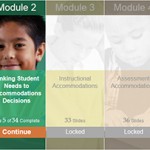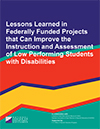Welcome
Welcome to the fall NCEO e-newsletter. In this issue, we highlight the findings from the 2012 survey of states—many interesting findings! Also, look for information on two new NCEO products—a tool that groups can use to build consensus on a topic, and a report on current state policies on accommodations for delivering assessments orally. We also highlight an innovative online training for educators to improve decisions made about accommodations for individual students. Finally, we highlight three manuals developed collaboratively by states, CCSSO, and NCEO, and published by CCSSO, to help guide accommodations decision making. As always, we welcome feedback and ideas about what you would like to see in future issues of NCEO’s e-newsletter.
 2012 Survey of States: Successes and Challenges During a Time of Change
2012 Survey of States: Successes and Challenges During a Time of Change
NCEO just published its thirteenth survey of states, the 2012 Survey of States: Successes and Challenges During a Time of Change. This report provides a snapshot of new initiatives, trends, accomplishments, and emerging issues. …
New Consensus Building Tool
The Multi-Attribute Consensus Building (MACB) method has been used by NCEO for over a decade to help groups prioritize strategies, decisions, recommendations, and policies based on participants’ perceptions. We make this tool available for your use. …
Accommodations Used to Deliver Assessments Orally
 There is wide variation across states in their accommodations policies for Human Reader, Text to Speech, and Pre-recorded Audio. A new NCEO report on this topic is now available: 2012 State Policies for Accommodations Used to Deliver Assessments Orally. …
There is wide variation across states in their accommodations policies for Human Reader, Text to Speech, and Pre-recorded Audio. A new NCEO report on this topic is now available: 2012 State Policies for Accommodations Used to Deliver Assessments Orally. …
Empowering Educators to Improve Accommodations Decision Making through Innovative Online Training
 NCEO recently rolled-out online training on accommodations decision making. The training includes case-based video clips, and contains five interactive, multi-media professional development modules. Educators are coached on best practices in how to select, administer, and evaluate the use of accommodations. …
NCEO recently rolled-out online training on accommodations decision making. The training includes case-based video clips, and contains five interactive, multi-media professional development modules. Educators are coached on best practices in how to select, administer, and evaluate the use of accommodations. …
New CCSSO Accommodations Manuals
We highlight three Accommodations Manuals the Council of Chief State School Officers (CCSSO) developed collaboratively by states, CCSSO, and NCEO. The manuals address assessment accommodations for students with disabilities, English language learners (ELLs), and ELLs with disabilities.

